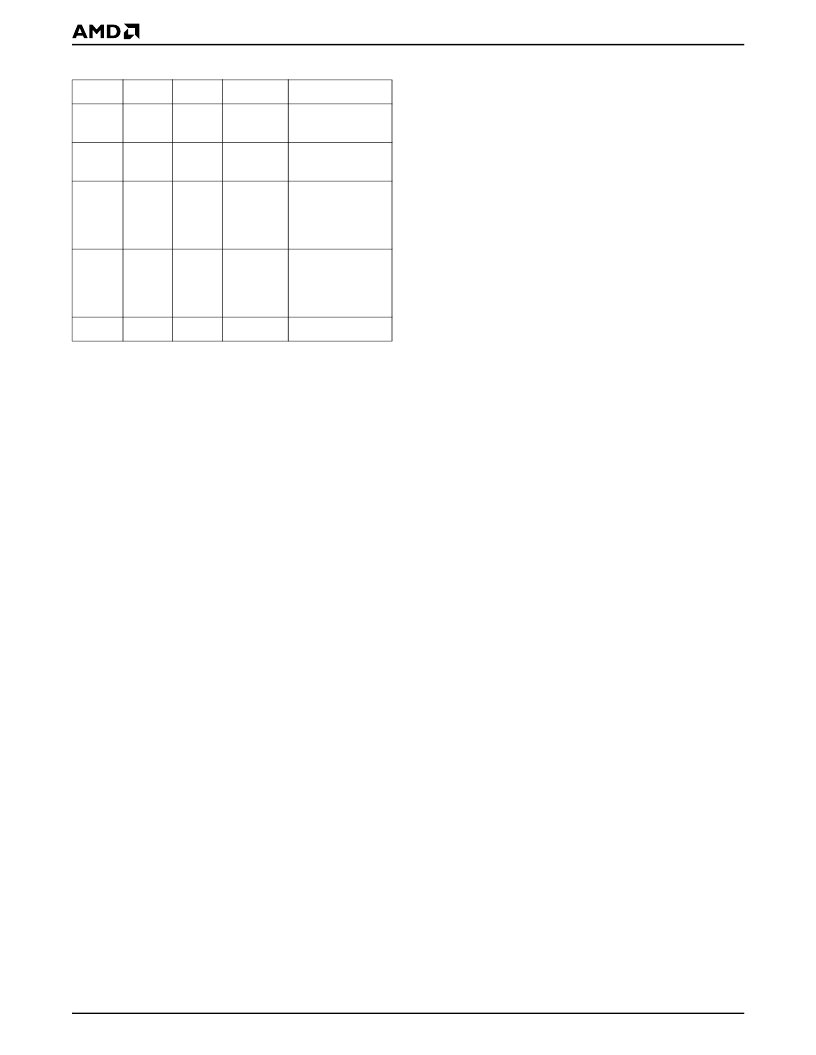- 您現(xiàn)在的位置:買賣IC網(wǎng) > PDF目錄366551 > AM79C978 (Advanced Micro Devices, Inc.) Single-Chip 1/10 Mbps PCI Home Networking Controller PDF資料下載
參數(shù)資料
| 型號(hào): | AM79C978 |
| 廠商: | Advanced Micro Devices, Inc. |
| 英文描述: | Single-Chip 1/10 Mbps PCI Home Networking Controller |
| 中文描述: | 單芯片的1 / 10 Mbps的家庭網(wǎng)絡(luò)控制器的PCI |
| 文件頁(yè)數(shù): | 72/261頁(yè) |
| 文件大小: | 3803K |
| 代理商: | AM79C978 |
第1頁(yè)第2頁(yè)第3頁(yè)第4頁(yè)第5頁(yè)第6頁(yè)第7頁(yè)第8頁(yè)第9頁(yè)第10頁(yè)第11頁(yè)第12頁(yè)第13頁(yè)第14頁(yè)第15頁(yè)第16頁(yè)第17頁(yè)第18頁(yè)第19頁(yè)第20頁(yè)第21頁(yè)第22頁(yè)第23頁(yè)第24頁(yè)第25頁(yè)第26頁(yè)第27頁(yè)第28頁(yè)第29頁(yè)第30頁(yè)第31頁(yè)第32頁(yè)第33頁(yè)第34頁(yè)第35頁(yè)第36頁(yè)第37頁(yè)第38頁(yè)第39頁(yè)第40頁(yè)第41頁(yè)第42頁(yè)第43頁(yè)第44頁(yè)第45頁(yè)第46頁(yè)第47頁(yè)第48頁(yè)第49頁(yè)第50頁(yè)第51頁(yè)第52頁(yè)第53頁(yè)第54頁(yè)第55頁(yè)第56頁(yè)第57頁(yè)第58頁(yè)第59頁(yè)第60頁(yè)第61頁(yè)第62頁(yè)第63頁(yè)第64頁(yè)第65頁(yè)第66頁(yè)第67頁(yè)第68頁(yè)第69頁(yè)第70頁(yè)第71頁(yè)當(dāng)前第72頁(yè)第73頁(yè)第74頁(yè)第75頁(yè)第76頁(yè)第77頁(yè)第78頁(yè)第79頁(yè)第80頁(yè)第81頁(yè)第82頁(yè)第83頁(yè)第84頁(yè)第85頁(yè)第86頁(yè)第87頁(yè)第88頁(yè)第89頁(yè)第90頁(yè)第91頁(yè)第92頁(yè)第93頁(yè)第94頁(yè)第95頁(yè)第96頁(yè)第97頁(yè)第98頁(yè)第99頁(yè)第100頁(yè)第101頁(yè)第102頁(yè)第103頁(yè)第104頁(yè)第105頁(yè)第106頁(yè)第107頁(yè)第108頁(yè)第109頁(yè)第110頁(yè)第111頁(yè)第112頁(yè)第113頁(yè)第114頁(yè)第115頁(yè)第116頁(yè)第117頁(yè)第118頁(yè)第119頁(yè)第120頁(yè)第121頁(yè)第122頁(yè)第123頁(yè)第124頁(yè)第125頁(yè)第126頁(yè)第127頁(yè)第128頁(yè)第129頁(yè)第130頁(yè)第131頁(yè)第132頁(yè)第133頁(yè)第134頁(yè)第135頁(yè)第136頁(yè)第137頁(yè)第138頁(yè)第139頁(yè)第140頁(yè)第141頁(yè)第142頁(yè)第143頁(yè)第144頁(yè)第145頁(yè)第146頁(yè)第147頁(yè)第148頁(yè)第149頁(yè)第150頁(yè)第151頁(yè)第152頁(yè)第153頁(yè)第154頁(yè)第155頁(yè)第156頁(yè)第157頁(yè)第158頁(yè)第159頁(yè)第160頁(yè)第161頁(yè)第162頁(yè)第163頁(yè)第164頁(yè)第165頁(yè)第166頁(yè)第167頁(yè)第168頁(yè)第169頁(yè)第170頁(yè)第171頁(yè)第172頁(yè)第173頁(yè)第174頁(yè)第175頁(yè)第176頁(yè)第177頁(yè)第178頁(yè)第179頁(yè)第180頁(yè)第181頁(yè)第182頁(yè)第183頁(yè)第184頁(yè)第185頁(yè)第186頁(yè)第187頁(yè)第188頁(yè)第189頁(yè)第190頁(yè)第191頁(yè)第192頁(yè)第193頁(yè)第194頁(yè)第195頁(yè)第196頁(yè)第197頁(yè)第198頁(yè)第199頁(yè)第200頁(yè)第201頁(yè)第202頁(yè)第203頁(yè)第204頁(yè)第205頁(yè)第206頁(yè)第207頁(yè)第208頁(yè)第209頁(yè)第210頁(yè)第211頁(yè)第212頁(yè)第213頁(yè)第214頁(yè)第215頁(yè)第216頁(yè)第217頁(yè)第218頁(yè)第219頁(yè)第220頁(yè)第221頁(yè)第222頁(yè)第223頁(yè)第224頁(yè)第225頁(yè)第226頁(yè)第227頁(yè)第228頁(yè)第229頁(yè)第230頁(yè)第231頁(yè)第232頁(yè)第233頁(yè)第234頁(yè)第235頁(yè)第236頁(yè)第237頁(yè)第238頁(yè)第239頁(yè)第240頁(yè)第241頁(yè)第242頁(yè)第243頁(yè)第244頁(yè)第245頁(yè)第246頁(yè)第247頁(yè)第248頁(yè)第249頁(yè)第250頁(yè)第251頁(yè)第252頁(yè)第253頁(yè)第254頁(yè)第255頁(yè)第256頁(yè)第257頁(yè)第258頁(yè)第259頁(yè)第260頁(yè)第261頁(yè)

72
Am79C978
Table 10.
Receive Address Match
Automatic Pad Stripping
During reception of an IEEE 802.3 frame, the pad field
can be stripped automatically. Setting ASTRP_RCV
(CSR4, bit 0) to 1 enables the automatic pad stripping
feature. The pad field will be stripped before the frame
is passed to the FIFO, thus preserving FIFO space for
additional frames. The FCS field will also be stripped,
since it is computed at the transmitting station based
on the data and pad field characters, and will be invalid
for a receive frame that has had the pad characters
stripped.
The number of bytes to be stripped is calculated from
the embedded length field (as defined in the ISO 8802-
3 (IEEE/ANSI 802.3) definition) contained in the frame.
The length indicates the actual number of LLC data
bytes contained in the message. Any received frame
which contains a length field less than 46 bytes will have
the pad field stripped (if ASTRP_RCV is set). Receive
frames which have a length field of 46 bytes or greater
will be passed to the host unmodified.
Figure 36 shows the byte/bit ordering of the received
length field for an IEEE 802.3-compatible frame format.
Since any valid Ethernet Type field value will always be
greater than a normal IEEE 802.3 Length field (
≥
46),
the Am79C978 controller will not attempt to strip valid
Ethernet frames.
Note that for some network protocols,
the value passed in the Ethernet Type and/or IEEE
802.3 Length field is not compliant with either standard
and may cause problems if pad stripping is enabled
.
Receive FCS Checking
Reception and checking of the received FCS is per-
formed automatically by the Am79C978 controller.
Note that if the Automatic Pad Stripping feature is en-
abled, the FCS for padded frames will be verified
against the value computed for the incoming bit stream
including pad characters, but the FCS value for a pad-
ded frame will not be passed to the host. If an FCS
error is detected in any frame, the error will be reported
in the CRC bit in RMD1.
Receive Exception Conditions
Exception conditions for frame reception fall into two
distinct categories, i.e., those conditions which are the
result of normal network operation, and those which
occur due to abnormal network and/or host related
events.
Normal events which may occur and which are handled
autonomously by the Am79C978 controller are basi-
cally collisions within the slot time and automatic runt
packet rejection. The Am79C978 controller will ensure
that collisions that occur within 512 bit times from the
start of reception (excluding preamble) will be automat-
ically deleted from the receive FIFO with no host inter-
vention.
The receive FIFO will delete any frame that is com-
posed of fewer than 64 bytes provided that the Runt
Packet Accept (RPA bit in CSR124) feature has not
been enabled and the network interface is operating in
half-duplex mode, or the full-duplex Runt Packet Ac-
cept Disable bit (FDRPAD, BCR9, bit 2) is set. This cri-
terion will be met regardless of whether the receive
frame was the first (or only) frame in the FIFO or if the
receive frame was queued behind a previously re-
ceived message.
Abnormal network conditions include:
FCS errors
Late collision
Host related receive exception conditions include
MISS, BUFF, and OFLO. These are described in the
Buffer Management Unit
section.
PAM
LAFM
BAM
DRCVBC
Comment
0
0
0
X
Frame accepted
due to PROM = 1
1
0
0
X
Physical address
match
0
1
0
0
Logical address
filter match;
frame is not of
type broadcast
0
1
0
1
Logical address
filter match;
frame can be of
type broadcast
0
0
1
0
Broadcast frame
相關(guān)PDF資料 |
PDF描述 |
|---|---|
| AM79C981 | Integrated Multiport Repeater Plus⑩ (IMR+⑩) |
| AM79C981JC | Integrated Multiport Repeater Plus⑩ (IMR+⑩) |
| AM79C982 | basic Integrated Multiport Repeater (bIMR) |
| AM79C982-4JC | basic Integrated Multiport Repeater (bIMR) |
| AM79C982-8JC | basic Integrated Multiport Repeater (bIMR) |
相關(guān)代理商/技術(shù)參數(shù) |
參數(shù)描述 |
|---|---|
| AM79C978A | 制造商:AMD 制造商全稱:Advanced Micro Devices 功能描述:Single-Chip 1/10 Mbps PCI Home Networking Controller |
| AM79C978AKC\\W | 制造商:Advanced Micro Devices 功能描述: |
| AM79C978AKC\W | 制造商:Advanced Micro Devices 功能描述: |
| AM79C978AKCW | 制造商:AMD 制造商全稱:Advanced Micro Devices 功能描述:Single-Chip 1/10 Mbps PCI Home Networking Controller |
發(fā)布緊急采購(gòu),3分鐘左右您將得到回復(fù)。